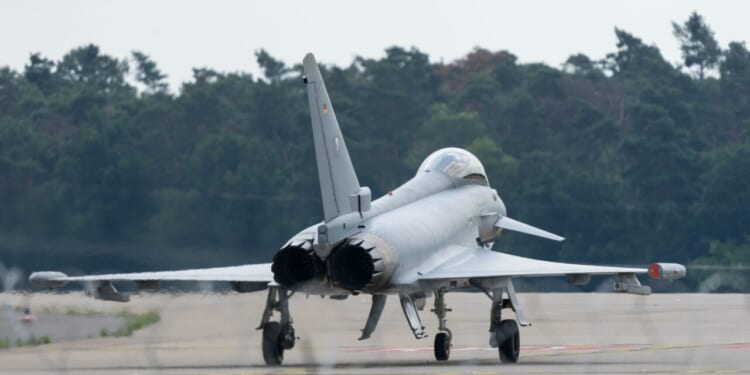Although not a fifth-generation aircraft, the Typhoon has advanced and modernized features.
As Russia’s invasion of Ukraine rages on, European nations continue to bolster their defense capabilities. Most recently, Germany greenlit the procurement of 20 additional Eurofighter Typhoon fighter jets. In a statement released to the public in early October, the German Ministry of Defense said that the combat jets would feature E-scan radars and other enhanced capabilities. The statement detailed, “‘The Eurofighter is the mainstay of the German combat aircraft fleet. The procurement of Tranche 5 [aircraft] serves to gradually transfer the capabilities of the aging Tornado fighter jet in the area of Electronic Combat and Reconnaissance (ECR) into a future-proof platform with which Germany will continue to’ honour its NATO objectives.” In addition to the Eurofighter purchase, Germany is also seeking to acquire new Boxer armored vehicles, new medium-range boats, and other defense equipment.
The Eurofighter platform has served as the backbone of Germany’s aerial fleet for years. During the Cold War, the multinational aircraft was conceptualized by the Future European Fighter Aircraft program. Spain, the UK, Italy, Germany, and France initially made up the project’s contributors; however, France eventually left the consortium to design its Dassault Rafale independently. The Typhoon aircraft embarked on its maiden flight in the early 1990s and has continued to serve the air forces of many nations honorably. Today, the Typhoon is in active service with the air forces of Italy, Austria, the UK, Spain, Oman, Saudi Arabia, Qatar, Kuwait, and, of course, Germany.
What Makes the Eurofighter Typhoon Stand Out
While the Typhoon is technically not a stealth platform, the aircraft retains low observable qualities that make it relevant while flying among newer fifth-generation aircraft. Some of the sophisticated features incorporated into the Typhoon include modular avionics, modern interface, super-cruising functions, powerful engines, AESA radar, and lethal armament capabilities. According to the platform’s Airbus manufacturer, the Typhoon can carry a vast array of ordinance within its 13 hardpoints, including air-to-air missiles like the AIM-120 AMRAAM, air-to-ground munitions like the Storm Shadow cruise missiles, and anti-tank missiles.
The Typhoon iteration Germany seeks to procure in the near future would likely be in the Phase 4 Enhancement (P4E) configuration. As part of this package, these advanced Typhoons could be equipped with an automated sensor management capability, improved cockpit interface, and enhanced Radio Frequency Interoperability. As detailed by The Aviationist, “In addition to the automated sensor management capability, P4E will introduce DASS (Defensive Aids Sub-System) upgrades for all customers and includes the IOC (Initial Operating Capability) for the additional German electronic warfare capability.”
Considering the Typhoon is not a fifth-generation series, its desirability stems from its advanced and modernizing features. The platform has participated in multinational drills flying alongside newer platforms like the American-made F-22 Raptor and F-35 Lightning II, demonstrating its relevance among technically more capable near-peers. Germany’s procurement of additional Typhoons will only elevate its aerial might and would undoubtedly come in handy if Russia’s war against Ukraine expands outward.
About the Author: Maya Carlin
Maya Carlin, National Security Writer with The National Interest, is an analyst with the Center for Security Policy and a former Anna Sobol Levy Fellow at IDC Herzliya in Israel. She has bylines in many publications, including The National Interest, The Jerusalem Post, and The Times of Israel. You can follow her on Twitter: @MayaCarlin.
Image: Sergey Kohl / Shutterstock.com


















